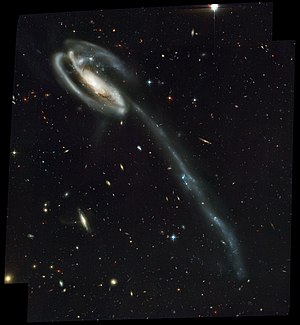UGC 10214
| Galaxie UGC 10214 | |
|---|---|
 | |
| Die Balkenspiralgalaxie UGC 10214 aufgenommen von Hubble Space Telescope | |
| AladinLite | |
| Sternbild | Drache |
| Position Äquinoktium: J2000.0, Epoche: J2000.0 | |
| Rektaszension | 16h 06m 03,915s[1] |
| Deklination | +55° 25′ 31,64″[1] |
| Erscheinungsbild | |
| Morphologischer Typ | SB(s)c pec[1] |
| Helligkeit (B-Band) | 14,6g mag |
| Winkelausdehnung | 3,6′ × 0,8′ |
| Inklination | 70° |
| Physikalische Daten | |
| Rotverschiebung | 0.031112 ± 0.000010[1] |
| Radialgeschwindigkeit | (9327 ± 3) km/s[1] |
| Hubbledistanz H0 = 73 km/(s • Mpc) | (424 ± 30) · 106 Lj (130,1 ± 9,1) Mpc [1] |
| Geschichte | |
| Katalogbezeichnungen | |
| UGC 10214 • PGC 57129 • MCG +09-26-056 • 2MASX J16060394+5525313 • Arp 188 • VV 29 • | |
UGC 10214, auch Tadpole Galaxy genannt, was zu deutsch Kaulquappengalaxie heißt, ist eine Balken-Spiralgalaxie vom Hubble-Typ SBc im Sternbild Draco am Nordsternhimmel. Sie ist schätzungsweise 424 Millionen Lichtjahre von der Milchstraße entfernt, der Schweif erstreckt sich über eine Länge von etwa 280.000 Lichtjahren.
Im selben Himmelsareal befinden sich unter anderem die Galaxien PGC 57108, PGC 57109, PGC 57087.
Schweif
Der Schweif stammt von einer Begegnung mit einer kleineren Galaxie, deren Gravitationskräfte Sterne, Gas und Staub aus der Ursprungsgalaxie heraussaugten. Dieses Material bildet den Schwanz mit seinen zahlreichen Sternentstehungsgebieten und Sternhaufen.
Halton Arp gliederte seinen Katalog ungewöhnlicher Galaxien nach rein morphologischen Kriterien in Gruppen. Diese Galaxie gehört zu der Klasse Galaxien mit schmalen Filamenten.
Sonstiges
In der Galaxie selbst wurden die Supernovae SN 2007cu (Typ-II) und SN 2008dq (Typ-Ic) beobachtet.[2]
Siehe auch
- Galaktische Gezeiten
- Wechselwirkende Galaxien
Literatur
- Jeff Kanipe und Dennis Webb: The Arp Atlas of Peculiar Galaxies – A Chronicle and Observer´s Guide, Richmond 2006, ISBN 978-0-943396-76-7
- Michael König und Stefan Binnewies: Bildatlas der Galaxien: Die Astrophysik hinter den Astrofotografien, Kosmos, Stuttgart 2019, S. 270
Weblinks
- Kollidierende und sich bildende Galaxien – Telepolis 1. Mai 2002
- Astronews
- Astronomy Pictures of the Day
- Spektrum.de: Amateuraufnahmen [1]
- ARP ATLAS OF PECULIAR GALAXIES
- Seligman Arp
Einzelnachweise
Auf dieser Seite verwendete Medien
UGC 10214 Tadpole Galaxy. This picture of the galaxy UGC 10214 was was taken by the Advanced Camera for Surveys (ACS), which was installed aboard the Hubble Space Telescope (HST) in March 2002 during HST Servicing Mission 3B (STS-109 mission). Dubbed the "Tadpole," this spiral galaxy is unlike the textbook images of stately galaxies. Its distorted shape was caused by a small interloper, a very blue, compact galaxy visible in the upper left corner of the more massive Tadpole. The Tadpole resides about 420 million light-years away in the constellation Draco. Seen shining through the Tadpole's disk, the tiny intruder is likely a hit-and-run galaxy that is now leaving the scene of the accident. Strong gravitational forces from the interaction created the long tail of debris, consisting of stars and gas that stretch our more than 280,000 light-years. The galactic carnage and torrent of star birth are playing out against a spectacular backdrop: a "wallpaper pattern" of 6,000 galaxies. These galaxies represent twice the number of those discovered in the legendary Hubble Deep Field, the orbiting observatory's "deepest" view of the heavens, taken in 1995 by the Wide Field and planetary camera 2. The ACS picture, however, was taken in one-twelfth of the time it took to observe the original HST Deep Field. In blue light, ACS sees even fainter objects than were seen in the "deep field." The galaxies in the ACS picture, like those in the deep field, stretch back to nearly the beginning of time.
